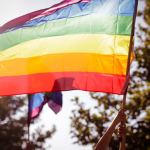Providers are working to improve their understanding and access of LGBTQ+ communities, historically a group underserved by hospice. Staff education, marketing and outreach oriented around the unique needs and challenges of LGBTQ+ patients will play a large role in reaching more of that population.
Issues of equity, inclusion and diversity have plagued the nation’s health care system, with hospices among the providers working to reach underserved communities. Available research indicates that the LGBTQ+ population is among those groups underutilizing hospice care.
Many in the LGBTQ+ community access palliative and hospice care too late or avoid it entirely. Some anticipate that they’ll face discrimiation from providers, according to Annie Acs, senior director of health policy and innovation at the National Hospice and Palliative Care Organization (NHPCO), who also serves as the staff liaison to NHPCO’s Diversity Advisory Council. Hospices should work to improve their understanding of LGBTQ+ patients, Acs told Hospice News.
“LGBTQ+ people come from all communities, races and backgrounds, and they frequently suffer from nearly all socioeconomic detriments of health at rates higher than heterosexual and cis-gendered people. It’s important that health care providers be adequately trained to address LGBTQ+ health disparities,” said Acs.
A 2018 AARP study found that 60% of the LGBTQ+ community is concerned about a lack of sensitivity to their needs among health care providers.
LGBTQ+ seniors 65 and older represented 7% of the United States population in 2019, according to a report from the UCLA School of Law Williams Institute. The number of individuals identifying as lesbian, gay, bisexual or transgender (LGBTQ+) exceeded 4.5% of the overall population in nearly 20 states and the District of Columbia, according to the report. Of these regions, 35% or fewer LGBTQ+ adults are raising children, according to NHPCO estimates.
Many LGBTQ+ patients lack family support or other caregivers in the home, according to Tim Johnston, director of national projects for SAGE, an advocacy group for LGBTQ+ seniors.
“LGBTQ+ people are less likely to be a part of multigeneration care networks and are more likely to be cared for by members of their chosen family, who are often similar in age. This makes it difficult to rely on informal care,” Johnston told Hospice News. “This means that LGBTQ+ people need to be sure they have made advanced planning decisions that ensure the right people will be able to help them as they near the end of life.”
Hospice and palliative care providers should educate staff on cultural competency, diversity, equity and inclusion, including the needs of the LGBTQ+ community, according to Johnston. Deepening clinicians’ understanding and awareness is an important first step of ensuring that staff are knowledgeable of key terminology, family dynamics and the LGBTQ+ experience.
One important consideration is that hospice providers should recognize that “family” is defined by the patient. The patient may consider certain people as family who are not related through genetics or marriage. This is critical when it comes to establishing guidelines for inpatient visitation, advance care planning and goals of care for LGBTQ+ patients, according to Altonia Garrett, vice president of public affairs and strategic partnerships at Virginia-based Capital Caring Health and executive director at the Center for Equity, Inclusion, and Diversity.
“Some considerations often do not have anything to do with the actual medical care, but rather the respect of the individual,” said Garrett. “One example that comes to mind relates to care of transgender patients and the use of pronouns. This is so extremely important as patients near the end of life, and even when they are no longer able to speak for themselves.”
Hospice organizations can begin with an internal review and update of their organizational policies to demonstrate a more inclusive and welcoming culture of the organization for LGBTQ+ team members.
A great first step can be using gender-neutral language in an organization’s literature and job notices, and showing diversity in images or photos. This creates a more welcoming environment for both patients and staff, according to Acs.
Adopting more inclusive language in marketing materials and community engagement will be vital to building lasting relationships and partnerships. Creating relationships with local LGBTQ+ services, non-profit organizations or community centers can help hospices improve their understanding of the barriers preventing access to care.
“Marketing is a key step, and it should be your last task on the journey to become more inclusive,” Acs told Hospice News. “That is because you only want to begin marketing to the LGBTQ+ community after you have completed the training and other best practices to ensure that LGBTQ+ people will be safe and supported accessing your services.”
This article was originally published in Hospice News on July 8, 2021.







